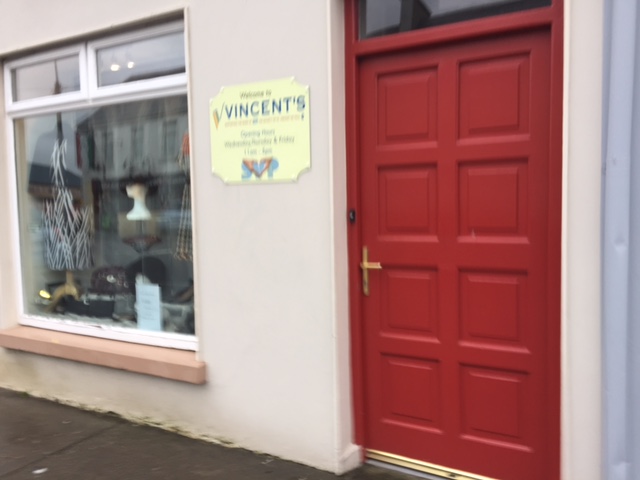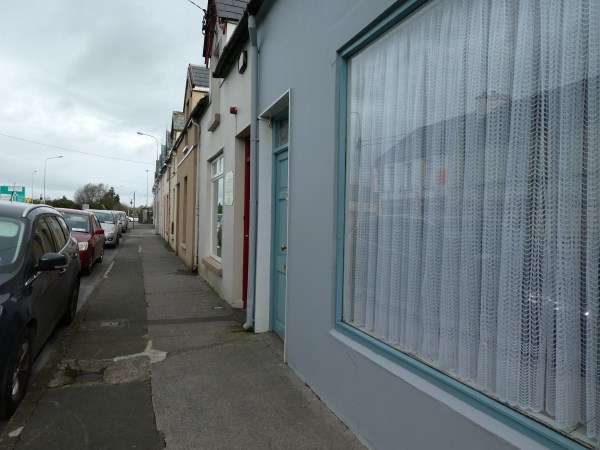Photo; Vincent Higgins, Mallow Camera Club
<<<<<<
Saturday Supplement
This photo was taken outside Jet Carroll's a few years ago. In it Frank Lewis is interviewing Vincent Carmody for his programme Saturday Supplement on Radio Kerry.
Frank plans to come again in May to record a programme on 50 years of Listowel Writers' Week
<<<<<<<
2013 NCBI Cake Sale
This photo was taken in the Mermaids. These kind ladies were all volunteers at the NCBI charity shop and they held a cake sale to raise extra funds.
<<<<<<
Covid 19
Vincents in Upper William Street, Listowel
I am going to share with you what I've learned about previous pandemics while I've been cooped up .
Spanish Flu spread like wildfire during the last year of the war, 1918. It killed more people than were killed in war, 50 million worldwide and 23,000 in Ireland alone.
TB or consumption was a very contagious respiratory illness which killed 10,000 Irish people in 1916 alone. It continued to ravage Ireland for most of the 20th century, until effective drug treatments and isolation hospitalisation brought it under control.
HIV/Aids was the dread of the 1980s when there were very poor prospects for people contracting this disease. To date over 9,000 people in Ireland have been diagnosed with Aids. Today, advances in drug treatment means that it is no longer a death sentence.
Sars killed 800 people in more than a dozen countries in 2003. Ireland had only one case.
Swine Flu was the pandemic of 2009. 27 people died in Ireland and half a million worldwide. A vaccine is now available.
Seasonal influenza comes our way every winter. while it is a serious illness, most vulnerable people protect themselves by vaccination.
The biggest difference between Covid 19 and previous pandemics is that it is very easily spread and, in a small but vulnerable cohort in the community it causes very severe respiratory problems.
As yet we have no vaccine or antidote.
<<<<<<<
Listowel March 16 2020
I was out around 10.00a.m. and I had the town to myself, almost.
<<<<<<<
Listowel March 16 2020
I was out around 10.00a.m. and I had the town to myself, almost.
<<<<<<<<
The Ballyeagh Fight
In Ireland in the 19th century fighting was a favourite sport. Good fighters were heroes in the neighbourhood. Local fights between rival families were looked forward to and talked about afterwards much as football matches are today.
The father and mother of all fights took place on Ballyeagh Strand near Ballybunion in 1834. It was a bloody battle, fought with viciousness by men and women. It became the stuff of legend. Below is an account from the Dúchas Schools' Folklore Collection
In June 1834 the Ballyeagh Fight took place on the White Strand Ballyeagh. It was one of the many faction fights of the time. At that time races would be held on the strand at low tide. Great numbers attended the meeting and tents lined the bank of the river on the Ballyeagh side - there is no strand at the other side. The factions engaged in this fight were the Lawlors principally from the Beal side and the Coolleens principally from the Ballyconry and Cashen side.
Evidently this was no sudden outburst for the parties were preparing for days before hand and came to the strand in military formation the Coolleens on horseback. Hacket and Aherne lead the Coolleens. They brought cart loads of stone to use in the fight. A little hay or straw was thrown over the stones and the women sat on top to allay suspicion.
Rev Father Buckley PP of Ballybunion met them a short distance from the strand and asked them to go home but they refused. Then he asked them to keep the peace and not spill blood but they told him they would.not return till they had defeated the Lawlors.










No comments:
Post a Comment